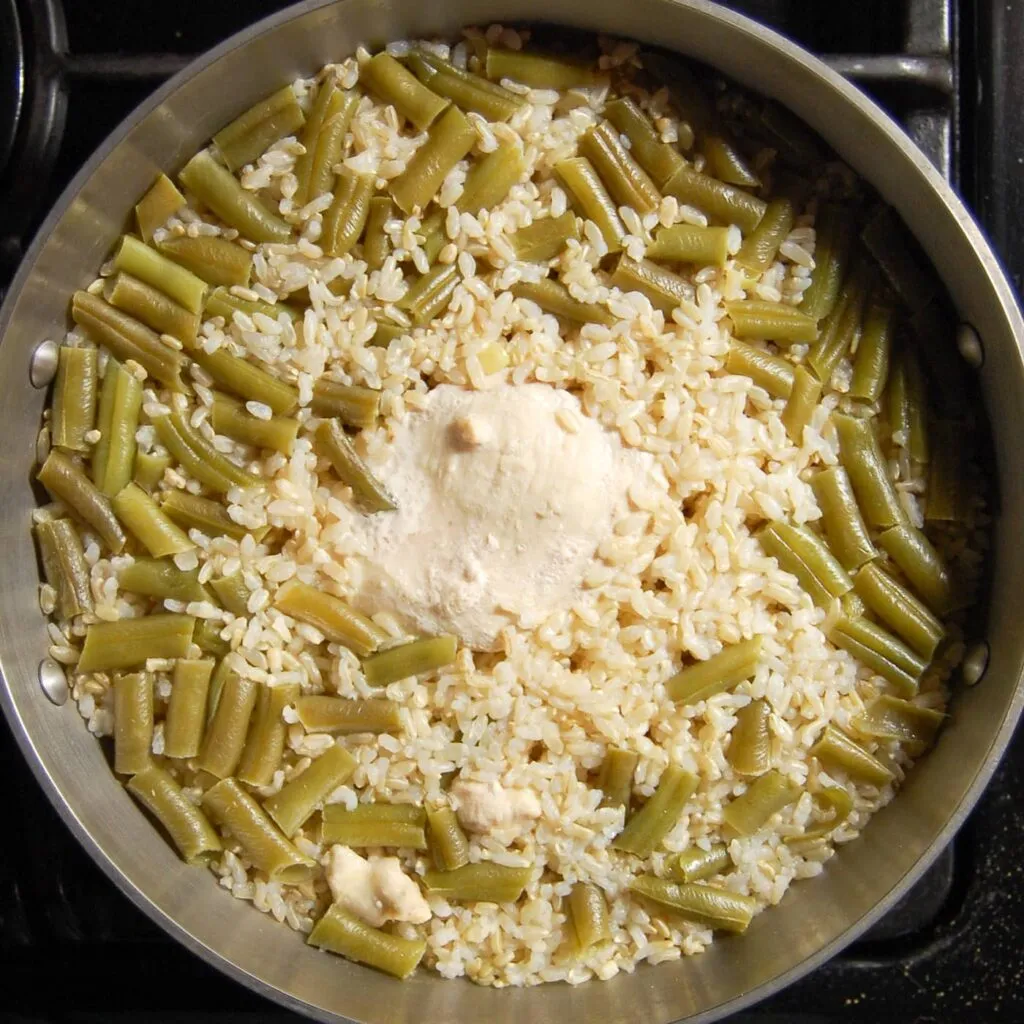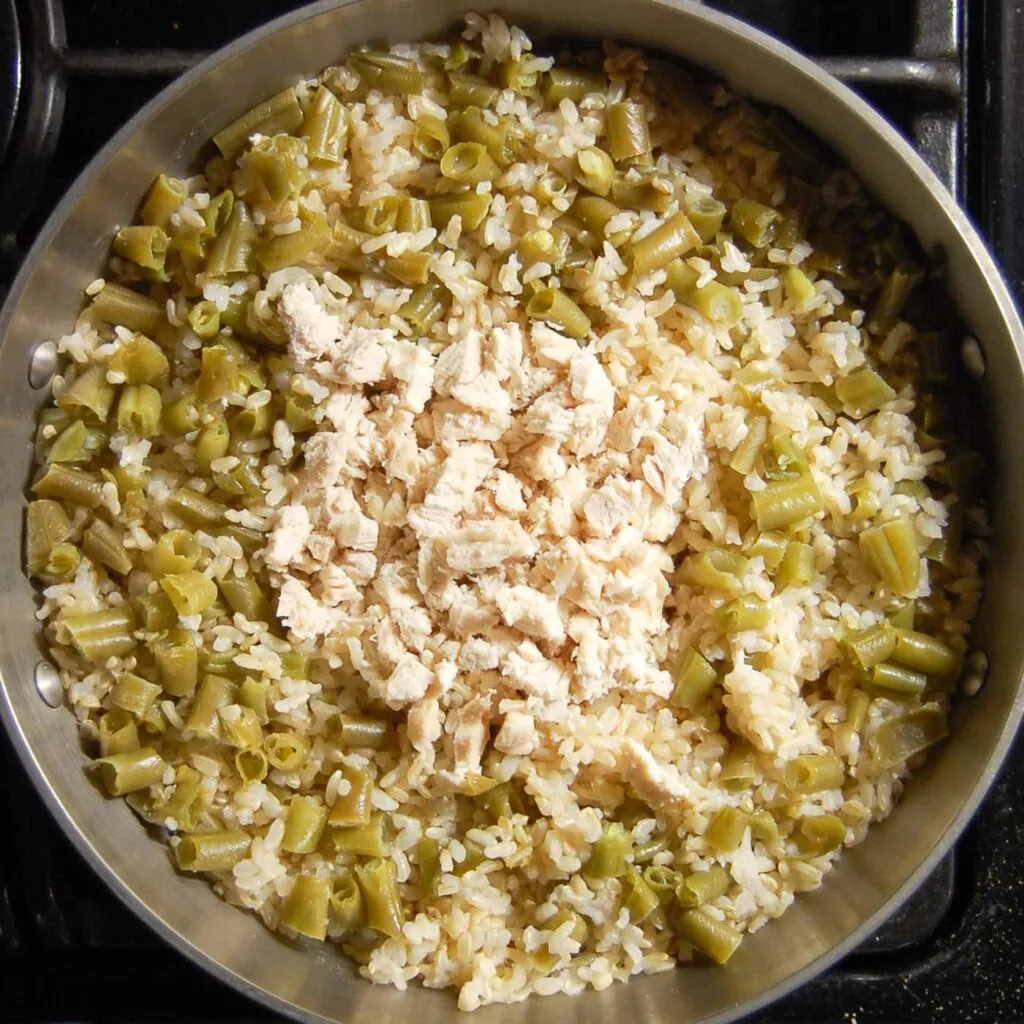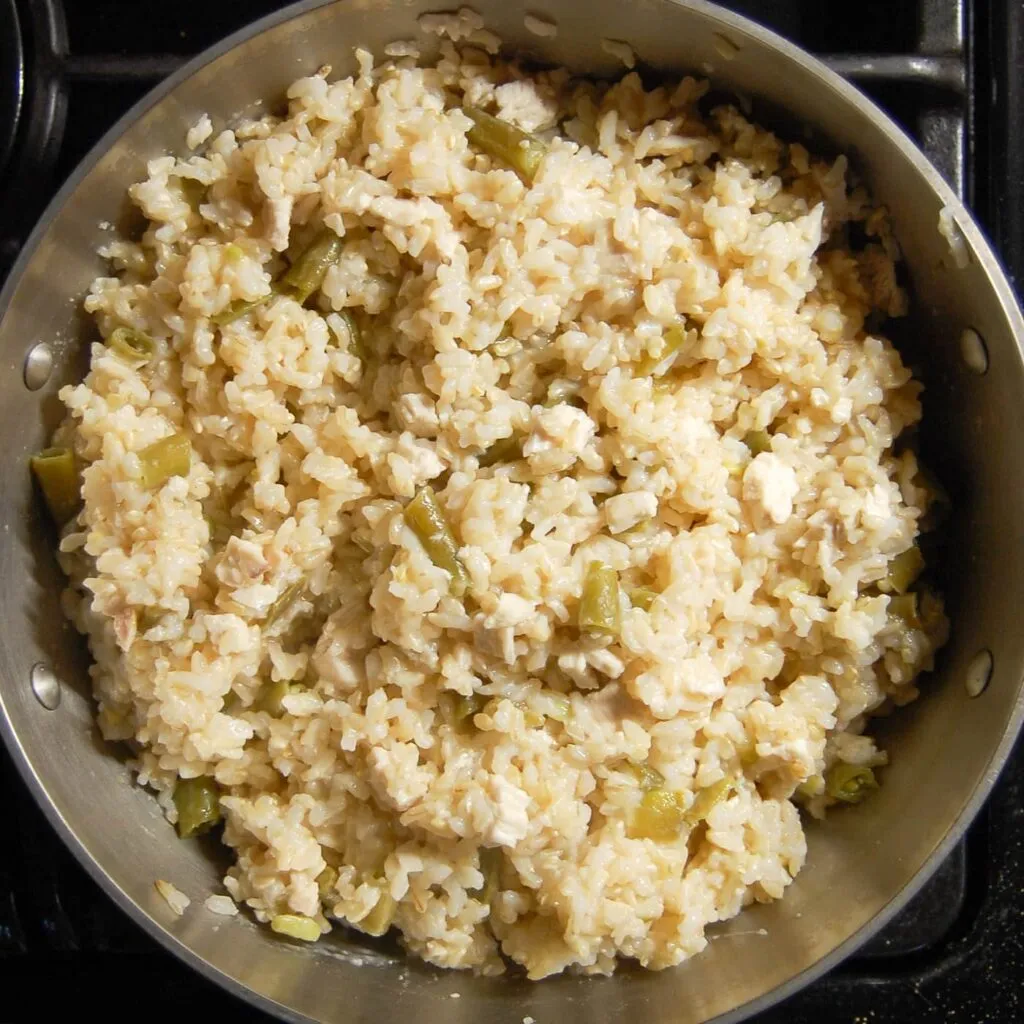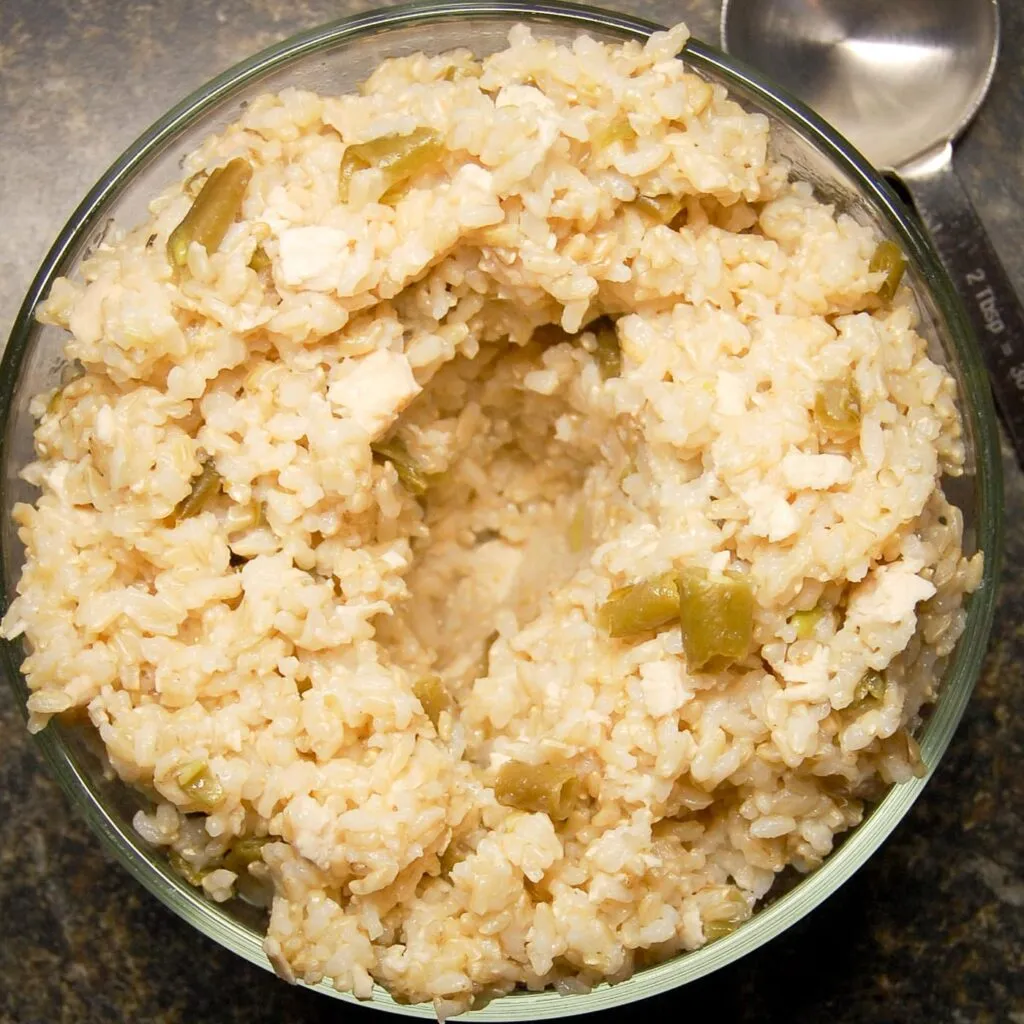When your canine companion isn’t feeling their best, or you simply want to enrich their daily diet with nutritious, wholesome ingredients, a Chicken And Rice Dog Food Recipe is a reliable and comforting choice. This incredibly simple, one-pot meal is designed to be easily digestible and appealing, making it a favorite for both pups and their owners. Whether you’re dealing with a sensitive stomach or looking for a healthy way to boost their appetite, this recipe offers a delicious solution.
As dedicated pet parents, we’ve all likely prepared boiled chicken and rice for our dogs at some point. It’s a go-to recommendation from veterinarians for managing digestive upset, such as an upset tummy or diarrhea, and is also beneficial during recovery periods. Similar to how we might reach for comforting foods when we’re under the weather, a simple chicken and rice meal can be a soothing balm for our dogs.
This recipe is not just for sick days; it’s also an excellent way to introduce beneficial whole foods into your dog’s regular diet. The preparation is straightforward, making it a cost-effective and time-saving option that brings immense joy through happy tail wags and enthusiastic mealtime anticipation. For those looking to explore more homemade options, consider a homemade dog food with chicken and rice for a complete nutritional picture.
An Appetite Stimulant for Picky Eaters
This versatile chicken and rice dog food recipe recently proved invaluable. Our beloved AndyBobby underwent surgery to remove a malignant mass from his jowl. While the surgical margins were excellent, his oncologist recommended a preventive course of chemotherapy. This treatment, involving daily medication for three months, began to diminish AndyBobby’s once-enthusiastic appetite.
Observing his waning interest in food, I started searching for ways to reawaken his culinary curiosity. Knowing his fondness for carbohydrates, I began incorporating a few tablespoons of this chicken and rice dish into his regular kibble. The effect was immediate and remarkably positive. Not only did AndyBobby’s appetite return, but his three canine companions also eagerly joined in, making me a “softie” who shared the wholesome meal with everyone. Meal times quickly became the highlight of their day.
The wonderful news arrived on December 18th: AndyBobby was declared cancer-free – the best Christmas gift imaginable.
 tri-colored dog with the sun on his faceAndyBobby on December 18, 2019.
tri-colored dog with the sun on his faceAndyBobby on December 18, 2019.
Even now, months later, chicken and rice remains a staple in our home. I cherish the added health benefits my dogs receive from these whole foods, and the minimal time and cost involved make it a sustainable practice. The extra tail wags and happy woofs at breakfast and dinner are a constant source of joy.
Mastering the Chicken and Rice Dog Food Recipe
The beauty of this chicken and rice dog food recipe lies in its simplicity. Everything cooks together in a single pot, dramatically reducing cleanup time.
I used to go through the extra effort of boiling chicken and steaming rice separately, then combining them. However, I discovered a far more efficient method: a one-pot approach that infuses the rice with the savory juices from the chicken, maximizing flavor. Who doesn’t appreciate a method that’s both easier and tastier? 🙋🏻♀️ 🐶
Here’s how it looks once it’s all done and ready for cooling and storage.
 chicken and rice for dogs after done cookingFreshly cooked chicken and rice.
chicken and rice for dogs after done cookingFreshly cooked chicken and rice.
 chicken and rice for dogs after cooking with cut up green beans and chicken breastChicken and vegetables chopped for serving.
chicken and rice for dogs after cooking with cut up green beans and chicken breastChicken and vegetables chopped for serving.
 chicken and rice for dogs with cut up green beans and chicken breast stirred togetherAll mixed and ready.
chicken and rice for dogs with cut up green beans and chicken breast stirred togetherAll mixed and ready.
 chicken and rice for dogs in glass bowl with crater formed in middle for faster coolingPrepared for cooling.
chicken and rice for dogs in glass bowl with crater formed in middle for faster coolingPrepared for cooling.
While the presentation might not be Michelin-star worthy – it’s essentially two pale ingredients with some overcooked green beans – the dogs’ reaction is what truly matters. If it helps restore my pup’s health, that’s the ultimate success.
If your dog finds this recipe appealing, they might also enjoy our home made dog food with turkey recipe, which offers another nutritious alternative.
Storage Guidelines
To properly refrigerate the chicken and rice mixture after cooking, create a small well or “crater” in the center. Allow it to cool on the counter for about 20 minutes before covering and transferring it to the refrigerator.
Stored correctly, this chicken and rice for dogs will remain fresh in the refrigerator for up to seven days.
For longer storage, you can freeze individual portions. Scoop small balls of the mixture onto a baking sheet lined with parchment paper and freeze for an hour. Once firm, transfer these frozen balls to a labeled and dated freezer bag. To serve, you can microwave a portion for 20-30 seconds before adding it to your dog’s kibble.
Frozen chicken and rice for dogs can be stored in the freezer for up to two months.
Key Tips for Success
Always pay close attention to the cooking time specified on your rice packaging.
Whole grain brown rice typically requires a longer cooking time, around 45-50 minutes, and necessitates more water than white rice. This is because the bran layer remains intact in brown rice, contributing to its characteristic color and texture.
White rice, having been stripped of its bran, cooks much faster, usually within 16-20 minutes, and requires less water.
Understanding these differences is crucial to prevent the rice from scorching. I’ve encountered packaged rice labeled as “brown” that cooked like white rice, lacking the satisfying chewiness of true brown rice.
We generally opt for brown rice as a daily meal topper. However, veterinarians often recommend white rice for dogs experiencing digestive issues, as its lower fiber content can be gentler on an upset stomach.
Regardless of the type of rice, your dog will likely enjoy this recipe. Our primary goal is to ensure the recipe yields delicious results for both you and your canine companion. 🥰
Frequently Asked Questions (FAQ)
Is brown or white rice better for dogs?
The best choice between brown and white rice for your dog largely depends on the reason you are feeding it.
Brown rice, with its intact bran layer, is richer in fiber. This makes it a lower-glycemic food compared to white rice, meaning it releases sugars into the bloodstream more slowly. For dogs, fiber can promote a feeling of fullness, but it’s also less easily digestible and generally not recommended for gastrointestinal issues or diarrhea.
White rice, conversely, is highly digestible. Veterinarians commonly suggest white rice for dogs suffering from an upset stomach. It’s easy to consume, gentle on the digestive system, and provides a quick source of energy.
For a healthy dog on a regular basis, brown rice offers superior nutritional benefits. White rice is best reserved for situations where you need to soothe your pup’s digestive system.
It is always advisable to consult your veterinarian for personalized advice on which type of rice is most suitable for your dog’s specific health condition. For further reading, PetMD offers a concise overview of rice for dogs here.
Can I feed my dog boiled chicken and rice every day?
The answer is nuanced: yes and no.
YES: Chicken, rice, and a variety of vegetables are beneficial for dogs. This recipe is specifically formulated to be gentle on upset stomachs, stimulate appetite, and add desirable variety to a dog’s standard diet.
NO: This should not constitute your dog’s entire diet. Even when supplemented with vegetables, boiled chicken and rice for dogs is not nutritionally complete. Your dog requires a broader spectrum of vitamins and minerals that are not present in chicken and rice alone. For comprehensive dietary options, explore blue buffalo wilderness dog food as an example of complete and balanced commercial diets.
How much chicken and rice should I give my dog?
In our household, we typically offer our dogs a couple of tablespoons of chicken and rice mixed with their kibble, often with a splash of warm water to moisten it. We adjust their kibble portion slightly to account for the added calories.
When a dog is unwell, our veterinarian’s recommendation is to feed smaller, more frequent meals consisting solely of chicken and rice for a day or two. This allows their digestive system a much-needed rest while they recover. It is crucial to ALWAYS consult your veterinarian when your dog is experiencing health issues and to prioritize their professional advice.
Related Recommendations
Your pup might also enjoy other recipes designed specifically for them. Give these a try:
- Homemade dog food with chicken and rice
- Fromm pork and applesauce dog food advisor
- Blue Buffalo senior dog food near me
Chicken & Rice for Dogs
Rating: 4.88 from 8 votes
Servings: 56
Calories: 28kcal per 2 tablespoons
Ingredients
- 4 cups water
- 2 cups whole grain brown rice (refer to notes for white rice substitution)
- 5 oz BONELESS chicken breast (fresh or frozen; never feed chicken bones to dogs!)
- 1 cup green beans (optional, fresh or frozen; see notes for safe vegetables for dogs)
Instructions
- Bring water to a boil over medium-high heat.
- Stir in the rice. Place the chicken breast and vegetables on top.
- Cover and simmer on low heat for 40-50 minutes, or until the rice has absorbed all the water and steam holes appear.
- Note: Whole grain brown rice requires approximately 50 minutes of cooking. If your rice package indicates a 20-minute cooking time, check for doneness sooner. I’ve encountered “brown rice” at the grocery store that lacked intact bran and cooked in about 20 minutes.
- Using kitchen shears or poultry shears, cut the chicken and vegetables into small, bite-sized pieces. Stir to combine.
- Transfer the mixture to a container. Create a well in the center and let it cool on the counter for about four hours. Cover and refrigerate. (This food safety step ensures adequate cooling before covering.) Store in the refrigerator; it will last for seven days.
- At meal times, add two tablespoons of chicken & rice to each cup of your dog’s kibble. We often add a little warm water to lightly moisten the mixture. Stir and enjoy watching your dog’s delight! A-rooo!
Notes
- Ensure that any vegetables you add are safe for dogs. Broccoli, squash, carrots, green beans, and peas are all good choices. Garlic, onions, grapes, and raisins are NOT safe for dogs.
- If using white rice, use 1 ¼ cups of water for each cup of rice and simmer for 18-20 minutes.
- Confirm that the chicken has reached an internal temperature of 165°F (74°C). Dogs can contract salmonella, just like humans.
- This recipe provides a supplement for breakfast and dinner for four dogs (each weighing 50-70 pounds) for approximately one week. Adjust the quantities to suit the needs of your dog(s) for a week’s supply.
Nutrition (per 2 Tablespoons)
- Calories: 28kcal
- Carbohydrates: 5g
- Protein: 1g
- Fat: 1g
- Saturated Fat: 1g
- Trans Fat: 1g
- Cholesterol: 2mg
- Sodium: 4mg
- Potassium: 32mg
- Fiber: 1g
- Sugar: 1g
- Vitamin A: 14IU
- Vitamin C: 1mg
- Calcium: 4mg
- Iron: 1mg
Equipment
- Fiesta 2 qt dog bowl
- OXO Angled Measuring Cup, 1 c
- RSVP Measuring Cups Set
- Tablecraft XL Measuring Spoons Set
- Mercer Culinary Yellow Santoku Knife, 7 in
- Saf-T-Grip Yellow Cutting Board, 18×12
- OXO Good Grips Kitchen Scissors
- Pyrex Food Storage Set
As an Amazon Associate, I may earn a small commission when you click a link and make a purchase. Thank you for supporting Yappy Kitchen!
Comments
4.88 from 8 votes (4 ratings without comment)
